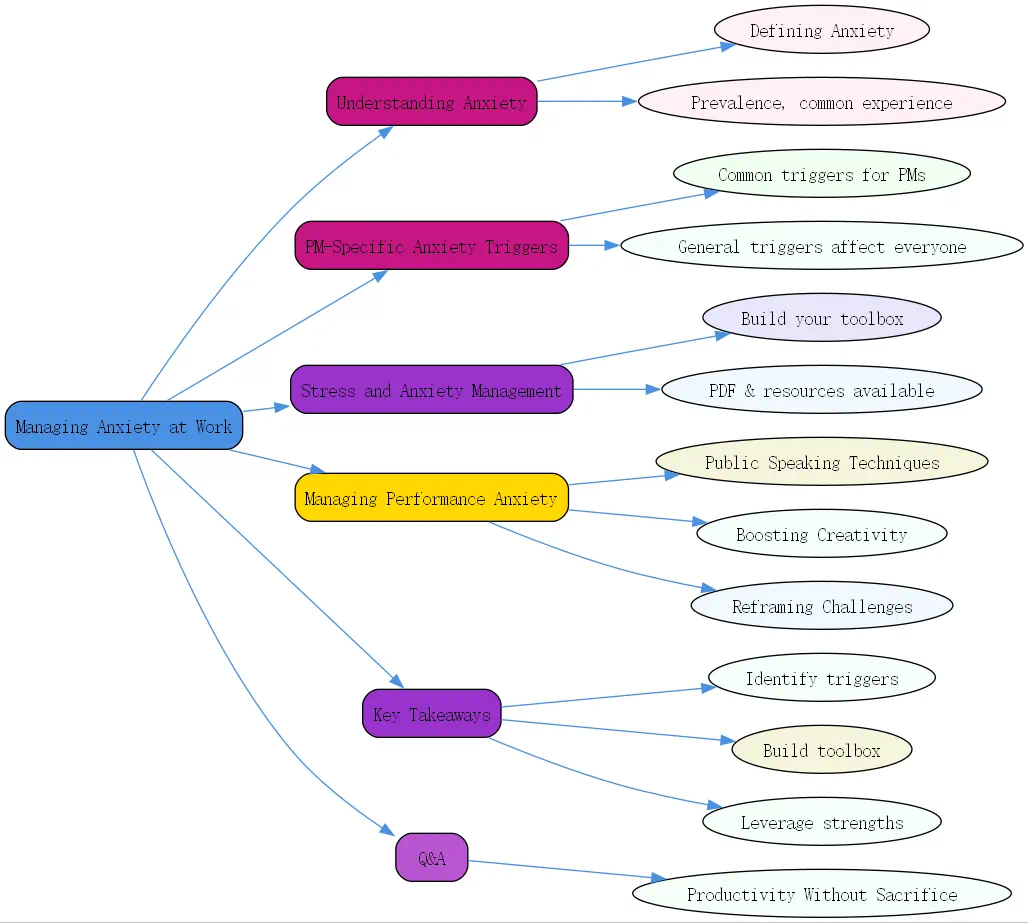Anxiety is a common yet often overlooked challenge in the workplace, especially for professionals like product managers who face unique pressures daily. At BrainTalking, we believe that understanding and addressing anxiety is key to thriving in your career. In this article, we’ll explore what anxiety is, its triggers in product management, and actionable strategies for managing stress and anxiety at work.
Understanding Anxiety in the Workplace

Defining Anxiety
Anxiety is characterized by intense, excessive, and persistent worry and fear about everyday situations. It can manifest physically through symptoms like a rapid heart rate, sweating, and difficulty concentrating. These feelings can interfere with daily activities, making it hard to perform at your best. According to the Mayo Clinic, generalized anxiety disorder (GAD) is particularly severe when it disrupts your ability to function effectively.
Prevalence of Anxiety

Anxiety is the most common mental health obstacle globally, affecting millions of people. Even if you don’t struggle with anxiety personally, chances are someone on your team does. This makes it essential to understand how anxiety impacts productivity and well-being in professional environments.
Personal Experiences with Anxiety
For many, anxiety isn’t just a theoretical concept—it’s deeply personal. For instance, Lee, a seasoned product manager, describes experiencing dry mouth, constricted breathing, and mental fog during episodes of anxiety. These physical symptoms highlight how overwhelming anxiety can feel, even for experienced professionals. Recognizing these signs early can help individuals take proactive steps toward managing anxiety at work.
Anxiety Triggers Specific to Product Management
Common PM Anxiety Triggers
Product managers face unique challenges that can exacerbate anxiety. Let’s break down some of the most common triggers specific to this role.
Interviewing Challenges
Interviewing as a product manager often involves thinking on your feet and answering complex questions under pressure. Rigorous interview loops at tech giants like Google or Amazon can heighten stress levels significantly. The need to demonstrate expertise while remaining calm can trigger anxiety for even the most qualified candidates.
PM Role Fit
Not every product management role aligns perfectly with an individual’s skills or interests. Being placed in a position that doesn’t match your strengths can lead to frustration and self-doubt, both of which fuel anxiety.
Balancing Stakeholder Needs
One hallmark of product management is balancing competing priorities among stakeholders. Whether it’s juggling customer feedback, engineering constraints, or executive expectations, the pressure to please everyone can become overwhelming.
Launching Products
The responsibility of launching a new product falls heavily on the shoulders of the product manager. From pre-launch planning to post-launch analysis, the weight of potential failure looms large, creating significant anxiety.
Time Management Issues
With endless to-do lists and tight deadlines, time management becomes a constant source of stress. Resource constraints only add to the burden, leaving PMs feeling stretched thin.
Interpersonal Relations
Navigating office dynamics, microaggressions, and trust issues can further complicate matters. Feeling unsupported or misunderstood by colleagues amplifies anxiety and hinders collaboration.
Performance Anxiety
From public speaking to generating innovative ideas, performance-related tasks can be daunting. Creative blocks and strategic pressures make managing performance anxiety critical for success.

Cognitive Load
The fast-paced nature of technology means there’s always more to learn. This relentless pursuit of mastery can leave PMs feeling inadequate and perpetually behind.
Decision Fatigue
Constant decision-making drains mental energy, leading to fatigue and heightened anxiety. Over time, this can erode confidence and focus.
General Anxiety Triggers Affecting Everyone
Beyond role-specific triggers, external factors such as family issues, financial stress, and global events also contribute to anxiety. Poor self-care habits—like inadequate sleep, poor nutrition, or lack of exercise—further compound the problem. Additionally, a fixed mindset or learned helplessness can hinder growth and resilience.
Strategies for Managing Stress and Anxiety at Work
Building Your Anxiety Management Toolbox
To effectively manage anxiety at work, start by identifying your triggers. Awareness allows you to anticipate and address potential stressors before they escalate. Next, focus on building a robust toolbox of coping mechanisms tailored to your needs.
The Good News
The good news is that anxiety doesn’t have to derail your career. By leveraging your strengths and passions, you can transform anxiety into motivation. Reflect on what aspects of product management energize you and use them as anchors during stressful times.
Focus on Strengths
Understanding what you enjoy and excel at helps fuel your confidence. For example, if strategizing excites you, lean into that skill to counterbalance other areas where you might feel less confident.

Anxiety Management Techniques PDF & Resources
For those seeking structured guidance, consider downloading an anxiety management techniques PDF. Such resources often include practical exercises like mindfulness practices, breathing techniques, and cognitive-behavioral strategies. External links to authoritative sources like the Mayo Clinic provide additional support.
Managing Performance Anxiety
Performance anxiety is a universal challenge, but it’s particularly relevant for product managers. Here are some targeted strategies to overcome it:
Techniques for Public Speaking
Public speaking anxiety can be mitigated through preparation and practice. Rehearsing presentations beforehand and visualizing success can boost confidence.
Boosting Creativity
Creative blocks can be frustrating, but brainstorming sessions, mind mapping, and collaborating with diverse teams can reignite innovation.
Reframing Challenges
Adopting a growth mindset transforms obstacles into opportunities. Instead of fearing failure, view challenges as stepping stones to improvement.
Takeaways
- Identify your personal triggers to better manage anxiety at work.
- Build a toolbox of coping mechanisms, including mindfulness and cognitive-behavioral techniques.
- Leverage your strengths to stay motivated and focused.
- Download an anxiety management techniques PDF for structured guidance.
Q&A Section
Q: How Can I Manage Stress and Anxiety at Work Without Sacrificing Productivity? A: Managing stress and anxiety at work requires a balanced approach. Start by prioritizing self-care—ensure you’re getting enough sleep, eating well, and exercising regularly. Use tools like time-blocking to manage your workload effectively. Additionally, incorporate short mindfulness breaks throughout your day to reset your focus. Finally, don’t hesitate to seek support from colleagues or a mental health professional if needed. BrainTalking offers valuable insights and resources to help you maintain productivity while safeguarding your mental health.




